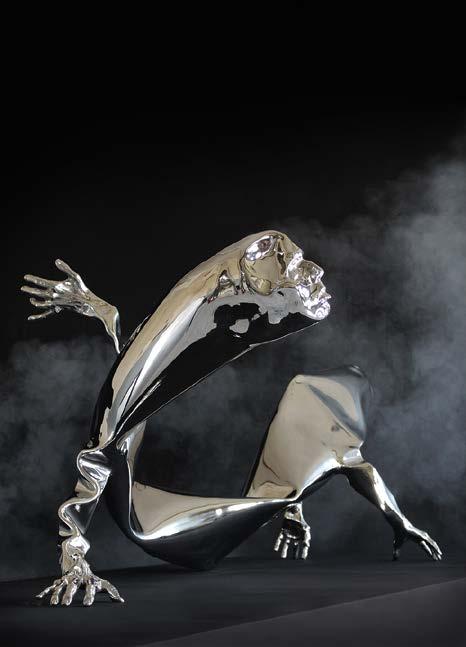
4 minute read
Editorial Alice Máselníková
Editorial: Hello again, and again
Hello again. So we are back. It feels as if I have been writing the same editorial for eternity now. But here it is, having shapeshifted through its various forms and themes. For the whole Supermarket team it has been an exhausting two years. To plan a large international art fair in the middle of this insecure time vacuum is, let’s admit it, quite insane. What was initially meant to be Supermarket 2020 was rescheduled, then cancelled, reformatted as Superlocal 2020, and now it takes form as Supermarket 2021, finally showing all those exhibitors we selected already back in 2019.
Advertisement
This only marks the fact that going forward often means taking quite a few steps backwards, or shifting sideways, or changing one’s plans completely. The past months made us somewhat introspective about our values and visions – what do we want the future Supermarkets to be like? What does it mean to ‘grow’ as an art fair? How can we become better and further strengthen the independent art scene? What have we gained and lost on the way to our present shape?
As this year’s theme, we decided to go with ‘Shapeshifters’, perhaps reflecting our desire to move forward while looking back. We have a good starting point for change with our brand new venue, Stadsgårdsterminalen, the former cruise ship terminal, in the middle of the city with a picturesque view of Stockholm’s waterfront. This year marks the 15th international edition of Supermarket – Stockholm Independent Art Fair and over the time we have metamorphosed, grown and shrunk, transitioned and moved around. Continuous change, flexibility and development are key characteristics of the artist-run scene – shaped by its variety, focus on cooperation, international character, underground nature, and simultaneously the lack of strong visibility, precarious economic structures, gaps in sharing of experience and tiredness with the bureaucratic system.
Shapeshifting is so alluring to us as it represents the possibility for a change for the better. It promises hope for a future contained in personal transformation, gives us power over our own destinies in times when we feel powerless; allows us to jump between dreams and realities. Shapeshifting is at the same time frightening as it serves as a reminder of judgment and justice, a righteous punishment to the wrongdoers, the fragility of existence easily tampered with by forces unknown to us. Acquiring a new shape was a common tactic of the Greek deities to implement their plans and passions – think of the ingenuity of Zeus transforming into golden rain to captivate Danae, into a bull to abduct Europa or a swan to reach Leda.
The idea of shapeshifting has been thrilling people throughout centuries in mythology, folk tales, literature, popular culture and religion. Shapeshifters can change their physical form, shifting between the human and inhuman, between one consciousness and another, through skills granted by magic – good or evil, superpowers or divine order. This duality of shapeshifting – voluntary or imposed, one a symbol of freedom, the other of confinement – is a mirror of real life transformations. Not every change is good or welcome. Changes feel better if we can actively take part in them. Life feels better if we believe ourselves to be powerful enough to shape our own destinies. Waking up to a bizarre reality preserves meaning only if we do not feel like a useless insect trapped in a scaled body in a small room.
In this issue of the Supermarket Art Magazine you will find a variety of angles on the elusive theme and the art world in general. Foad Alijani presents a poetic pondering on the transformation of the city of Tehran, Iran, portraying it as a living and breathing organism taken throughout the years with a mind of its own. As a part of a guest insert by C-Print, Ashik Zaman and Edith Ekström bring us closer to the current happenings on the Malmö art scene, giving the image of a strong movement of artist-run initiatives with a collaborative and supportive environment – an alternative to Stockholm’s independent galleries. A quite special insert filled with love and unabashed appreciation is that of ‘Analogue likes’ designed by CrashBoomBang Studios. Do you adore someone? Do you love something? Tear your feelings off the page and give out some love. Be brave. When else if not now?
textur magazine’s floorplan of a hypothetical workspace ponders the often rigid concept of an office and offers a fresh take on the working environment that is collectively shaped, flexible and in a constant flux. Stuart Mayes brings the third and last part of his series of articles on the impact of Brexit on the contemporary art scene. What has changed since last year and does the horizon look any brighter for British artists? In the interview department the magazine features an interview with GHLOW, a
Swedish-Russian music duo consisting of
Emille de Blanche and Nikolay Evdokimov.
GHLOW are Supermarket 2021’s guest band performing at the opening night, and we get a glimpse into their music and connection to the visual arts. As mutual support and collaboration in the artist-run world are some of Supermarket’s millstones, we also highlight other events that strengthen the artist-run scene. You can find two interviews: with the three directors of the latest addition to the independent art fair scene, Juxtapose Art Fair, Pamela Grombacher, Jacob Juhl and SashaRose Richter; and with the founder and artistic director of Platform Projects, Artemis Potamianou.
Last but not least, the celebration, the introspection, and the vision, all combined in eleven questions about the past and the future to each of the three creative directors, as a honorary part of our anniversary reflection.
We do not know what this year or the coming years will bring us, but we keep on shapeshifting, makeshifting, upshifting. Enjoy the reading!







